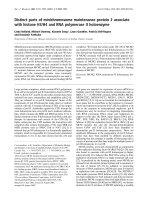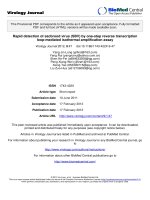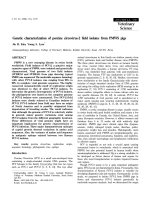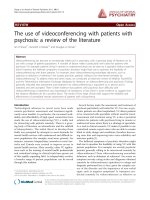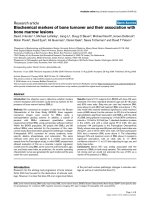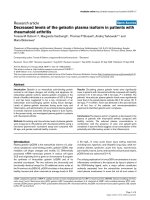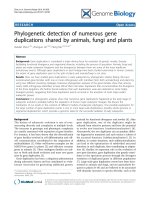Báo cáo y học: " Rapid detection of porcine circovirus type 2 using a TaqMan-based real-time PCR" doc
Bạn đang xem bản rút gọn của tài liệu. Xem và tải ngay bản đầy đủ của tài liệu tại đây (246.39 KB, 5 trang )
SHOR T REPOR T Open Access
Rapid detection of porcine circovirus type 2 using
a TaqMan-based real-time PCR
Kai Zhao
1,3
, Fangting Han
4
, Yong Zou
2,3
, Lianlong Zhu
1,3
, Chunhua Li
2,3
, Yan Xu
4
, Chunling Zhang
2,3
, Furong Tan
1,3
,
Jinbin Wang
1,3
, Shiru Tao
1,3
, Xizhong He
2,3
, Zongqing Zhou
2,3
, Xueming Tang
1,3*
Abstract
Porcine circovirus type 2 (PCV2) and the associated disease postweaning multisystemic wasting syndrome (PMWS)
have caused heavy losses in global agriculture in recent decades. Rapid detection of PCV2 is very important for the
effective prophylaxis and treatment of PMWS. To establish a sensitive, specific assay for the detection and
quantitation of PCV2, we designed and synthesized specific primers and a probe in the open reading frame 2. The
assay had a wide dynamic range with excellent linearity and reliable reproducibility, and detected between 10
2
and 10
10
copies of the genomic DNA per reaction. The coefficient of variation for Ct values varied from 0.59% to
1.05% in the same assay and from 1.9% to 4.2% in 10 different assays. The assay did not cross-react with porcine
circovirus type 1, porcine reproductive and respiratory, porcine epidemic diarrhea, transmissible gastroenteritis of
pigs and rotavirus. The limits of detection and quantitation were 10 and 100 copies, respectively. Using the
established real-time PCR system, 39 of the 40 samples we tested were detected as positive.
Introduction
Porcine circovirus type 2 (PCV2) is widespread in the
commercial swine population [1-5], and is accepted as
the causative agent of a number of diseases in these ani-
mals, particularly postweaning multisystemic wasting
syndrome (PMWS) [6]. To date, PCV2 infection is com-
mon in some regions of China [7], and is considered as
a major problem in pig production. There is therefor e
an urgent need for specific and effective methods to
detect the virus.
By comparison with conventional PCR and ELISA,
real-time PCR offers an eff ective way to detect target
fragments specifically, rapidly and quantitatively. False-
positive re sults and pollution can be prevented eff ec-
tively at the same time. Therefore, real-time PCR has
been developed quickly and has become the main
method for pathogen detection [8].
In this study, we designed and synthesized specific pri-
mers and a TaqMan probe for PCV2. We have estab-
lished an assay that is specific and sensitive for
detection and quantitation of PCV2.
Materials and methods
Design of primers and TaqMan probe
The primer a nd TaqMan prob e design were based on
nucleotide sequences of open reading frame 2 (ORF2)
retrieved from GenBank (EU921257.1), using the PCV2
strain from China (BJ0804) as a master sequence. The
primers and probe (Table 1) were designed using Pri mer
Premier 5.0, Oligo Primer Analysis software and DNA-
man 4.0. The length of the amplified product was 149 bp.
Preparation of standard plasmid DNA
The standard plasmid was constructed by inserting a
PCR fra gment into a pGEM-T Easy vector accord ing to
the manufacturer’s instructions (Promega, Madison, WI,
USA). The plasmid was propagated in Escherichia col i
JM109 cells and was purified and subsequently quanti-
fied using an ND-1000 spectrophotometer (NanoDrop,
Wilmington, DE, USA). Ten-fold dilutions were made
to obtain 10
10
-10
0
per μL plasmid sample (containing
100 ng/μL yeast tRNA) for the real-time PCR. The dilu-
tions were sto red at - 20°C, while the plasmids were
stored at -70°C.
Conventional PCR reaction
PCR amplifications were performed in 25-μL reaction
volumes containing 1×PCR buffer, 200 μMdATP,
* Correspondence:
1
Biotechnology Research Institute, Shanghai Academy of Agricultural
Sciences, 2901 Beidi Road, Shanghai, 201106, People’s Republic of China
Full list of author information is available at the end of the article
Zhao et al. Virology Journal 2010, 7:374
/>© 2010 Zhao et al; licensee BioMed Central Ltd. This is an Open Access article distributed under the term s of the Creative Commons
Attribution License (http://creati vecommons.org/licenses/by/2.0), which permits unrestricted use , distribution, and reproduction in
any me dium, provided the original work is properly cited.
dTTP, dCTP and dGTP, 1.25 U DNA polymerase,
2mMMgCl
2
(TaKaRa, Dalian, China), 200 nM of each
primer, and different quantities of the plasmid DNA
templates. Amplifications were programmed as follows:
onestepof94°Cfor5min,30cyclesof94°Cfor30s,
60°C for 20 s and 72°C for 20 s, and one step of 72°C
for 7 min. Amplicons of 149 bp were separ ated throug h
2% agarose gel containing 5% Goldview (SBS Genetech,
Shanghai, China). Negative and positive reference sam-
ples were applied in each reaction.
TaqMan real-time PCR
Real-time PCR was carried out on an ABI 75 00 th ermo-
cycler (Applied Biosystems, CA, USA) with a final
volume of 25 μL. The real-time PCR reactions contained
the following ingredients: 1×PCR buffer, 400 nM pri-
mers, 200 nM TaqMan probes, 400 μM each of dATP,
dTTP, dGTP and dCTP, 1.25 U Taq DNA polymerase,
and 4.5 mM MgCl
2
. Real-time PCR reactions were run
as follows: 95°C for 10 min and 45 cycle s of 95°C for
15 s and 60°C for 40 s. For a standard curve, serial dilu-
tions of 10
10
to 10
0
copies of the plasmid were used.
Each assay was performed in duplicate and each run
included two negative controls.
Limits of detection and quantitation of the assay
To establish the limit of quantitation (LOQ) of the
assay, samples containing 10
7
,10
5
,10
3
and 10
2
copies
per sample were run in triplicate, and samples contain-
ing 9 0, 80, 70, 60, 50, 4 0, 30 and 20 copies were al so
included. Samples containing 10 copies and one copy
per sample were also run to est imate the limit of detec-
tion (LOD) of the assay.
Reproducibility and specificity of the assay
The standard PCV2 plasmid with 10
7
,10
5
and 10
3
copies was used to evaluate the coefficients of variation
(CVs) of the real-time PCR. Int ra- and int er-assay CVs
for Ct values were both included. To test the specificity
of the assay, plasmid samples containing 10
8
,10
7
,10
6
,
10
5
and 10
4
copies together with cDNA of porcine
reproductive and respiratory, porcine epidemic diarrhea,
transmissible gastroenteritis of pi gs and rotavirus and
DNA of porcine circovirus type 1 were run under opti-
mal conditions of the assay. Negative controls were also
contained in the run.
Detection of clinical samples
Three PCV2-positive samples and 37 serum and tis-
sue unknown samples were tested u sing conventional
PCR and real-time PCR under optimal conditions.
Products from conventional PCR were examined in
2% agarose gel.
Results
Real-time PCR for PCV2 DNA
Ten-fold serial plasmid dilutions were used to construct
the standard curve by plotting the logarithm of the plas-
midcopynumberagainstthemeasuredCtvalues
(Figure 1). The standard curve generated had a wide
dynamic range of 10
2
-10
10
copies/μL with a linear corre-
lation (R
2
) of 0.9999 between the Ct value and the loga-
rithm of the plasmid copy number.
LOD and LOQ of the assay
For reliable quantit ation of the results under ideal con-
ditions, approximately 100 initial template copies were
required, thereby specifying the LOQ of this assay.
When the number of template copies fell below 100, the
Ct values lay outside of the linear range (Figure 2). The
target sequence could be detected in all amplification
reactions down to 10 copies, but not when only one
copy was present (Figure 3). These r esults indicate that
the LOD value was ~10 copies.
Reproducibility and specificity of the assay
The CVs for the Ct values ranged from 0.59% to 1.05%
in the same assay and from 1.9% to 4.2% in 10 different
assays (Table 2). No increase in fluorescence was
observed in the negative control and PCV1, PRRS, PED,
TGE and RV samples.
Detection of clinical samples
Table 3 an d 4 showed that the PCV2-positive rates in
the unknown samples of c onventional PCR detection
and real-time PCR detection we re 78.3% and 97.3%,
respectively. The real-time PCR approach increased the
Table 1 Sequences of primers and probe of PCV2
Primes and probe Sequence
Primer-1 5’-CGGATATTGTAKTCCTGGTCGTA-3’
Primer-2 5’-CCTGTCCTAGATTCCCCTATTGATT-3’
Probe FAM-5’-CTAGGCCTACGTGGTCTACATTTC-3’-TAMRA
\ [
5
3ODVPLG&RS\1XPEHU/RJ
7KUHVKROG&\FOH&7
Figure 1 Standard curve between Ct value and log
10
copy
number of PCV2 plasmid DNA.
Zhao et al. Virology Journal 2010, 7:374
/>Page 2 of 5
detection of PCV2 samples by 18% over that achieved by
conventional PCR.
The viral loads were mostly betw een 10 and 1000
copies/μL sample w ith a f ew samples containing up to
10
8
copies/μL. Three hundred and sixty and 1560 copies
of PCV2 were detected per microliter in the PPV and
PRV DNA extracted from serum samples. It appeared
that the pigs from which the PPV and PRV DNA sam-
ples were obtained were co-infected with PCV2.
Discussion
Serological surveys have shown that up to 1 00% of
investigated farms and up to 100% of individual pigs
sampled in parts of Europe, the United States and
Canada are seropositive for PCV2 [9-11]. Using ELISA
on samples collected in seven provinces and municipali-
ties in China, the seropositive rate was found to be up
to 42.9% [12].
PCV2-induced diseases on farms are reported to
increase pig mortality from 2-3% to 14-30% [13]. Ther e-
fore, rapid and sensitive detection and quantitation
assays for PCV2 are urgently needed both by the pig
industry and research commun ity. In comparison with
conventional PCR, TaqMan real-ti me PCR is more sen-
sitive and less easily contaminated. The main difficulty
of using conventional PCR is that contamination occurs
when products are e xamined in gels, which leads to
false-positive results in later experiments. For this rea-
son, real-time PCR is widely used, and in addition, it
has heightened sensitivity and requires less t ime than
conventional PCR.
The major conserved region for PCV2 located in
ORF2 is likely to be the ideal reference fragment to
detect PCV2, because this region displays the highest
diversity between PCV1 and PCV2 and there are more
sequenced isolates avai lable from PCV2 than t here are
from PCV1 [14]. Hybridization probes that combine
only with the target products have primarily been used
in previous studies to detect PCV2, and the resul ts of
these studies have shown high sensitivity and specificity.
Several other methods are available to detect and quan-
tify PCV2. B runborg et al. [14] have used a TaqMan
probe to detect an 84-bp fragment in ORF2 and to
quantify the viral load in different tissues and serum
samples.InareportbyChungetal.[15],PCV2was
quantified in naturally infected and challenged pigs
Figure 2 Determination of the limit of quantitation.
Figure 3 Determination of the limit of detection. The yellow and blue curves reveal the fluorescence values observed in samples containing
10 and 1 copies of PCV2 plasmid respectively.
Zhao et al. Virology Journal 2010, 7:374
/>Page 3 of 5
using a TaqMan real-time PCR that detected a fragment
of 269 bp. Yang et al. [16] have used SYBR Green I
based on nucleot ide sequences o f ORF2 for the detec-
tion of PCV2.
In this study we designed different primers, a different
probeandadifferentreal-timePCRsystem,which
amplified a 149-bp fragment to detect PCV2. The real-
time PCR approach inc reased the detection of PCV2
samples by 18% over that achieved by conventional
PCR. Tests on the reproducibility of the method suggest
that the established real-time PCR system appears to be
reliable and stable. A series of experime nts were carried
out to assess the reproducibility, sensitivity, and specifi-
city of the assay. Using several other swine viruses as
template, no cross-reac tion signals were detected, which
demonstrated the s pecificity of the assay. The estab-
lished real-time PCR system that we developed might
not only provide an effective way to detect PCV2 rapidly
and sensitively, but might also be a pplied to assess the
effectiveness of vaccines developed to combat PCV2.
The real-time PCR dete ction system complements and
extends previous methods for detection and quantitation
of PCV2. The specific detection method can also pro-
vide an alternative approach for detection of PCV2.
Abbreviations
bp: base pair; cDNA: complementary DNA; LOD: limit of detection; LOQ: limit
of quantitation; ORF2: open reading frame 2; PCV1: Porcine circovirus type 1;
PCV2: Porcine circovirus type 2; PED: Porcine epidemic diarrhea; PMWS:
Postweaning multisystemic wasting syndrome; PPV: Porcine parvovirus; PRRS:
Porcine reproductive and respiratory; PRV: Pseudorabies virus; RV: Rotavirus;
TGE: Transmissible gastroenteritis of pigs;.
Acknowledgements
This work was financially supported by Shanghai Agricultural Science
Committee foundation of China, grant no.2009-6-4 International Cooperation
Foundation of Shanghai grant no.10410703500, Shanghai agricultural science
key research project, grant no. 2008-8-5.
Author details
1
Biotechnology Research Institute, Shanghai Academy of Agricultural
Sciences, 2901 Beidi Road, Shanghai, 201106, People’s Republic of China.
2
Institute of Animal Science and Veterinary Medicine, Shanghai Academy of
Agricultural Sciences, 2901 Beidi Road, Shanghai, 201106, People’s Republic
of China.
3
Key Laboratory of Agricultural Genetics and Breeding, Shanghai
Academy of Agricultural Sciences, 2901 Beidi Road, Shanghai, 201106,
People’s Republic of China.
4
College of Life and Environment Sciences,
Shanghai Normal University,100 Guilin Road, Shanghai 200234, People’ s
Republic of China.
Authors’ contributions
KZ, FH and XT participated in the design and carried out the majority of the
experiments in the study and drafted the manuscript. YZ, LZ, CL, YX, CZ, FT,
JW, ST, XH, ZZ and XT helped to carry out the experiments and draft the
manuscript. All authors read and approved the final manuscript.
Competing interests
The authors declare that they have no competing interests.
Received: 31 August 2010 Accepted: 31 December 2010
Published: 31 December 2010
References
1. Allan GM, Ellis JA: Porcine circoviruses: a review. J Vet Diagn Invest 2000,
12:3-14.
2. Ellis J, Clark E, Haines D, West K, Krakowka S, Kennedy S, Allan GM: Porcine
circovirus-2 and concurrent infections in the field. Vet Microbiol 2004,
98:159-163.
3. Segales J, Domingo M: Postweaning multisystemic wasting syndrome
(PMWS) in pigs: a review. Vet Q 2002, 24:109-124.
4. Segales J, Rosell C, Domingo M: Pathological findings associated with
naturally acquired porcine circovirus type 2 associated disease. Vet
Microbiol 2004, 98:137-149.
5. Brunborg IM, Jonassen CM, Moldal T, Bratberg B, Lium B, Koenen F,
Schönheit J: Association of myocarditis with high viral load of porcine
circovirus type 2 in several tissues in cases of fetal death and high
mortality in piglets: a case study. J Vet Diagn Invest 2007, 19:368-375.
6. Allan GM, McNeilly F, Meehan BM, Kennedy S, Mackie DP, Ellis JA, Clark EG,
Espuna E, Saubi N, Riera P: Isolation and characterization of circoviruses
from pigs with wasting syndromes in Spain, Denmark and Northern
Ireland. Vet Microbiol 1999, 66:115-123.
7. Wu DM, Cao YC, Bi YJ: Research progress of porcine circovirus: a review.
Chin J Prev Vet Med 2004, 26(1):76-78.
Table 2 Intra- and inter-assay reproducibility of the real-time PCR
Concentration of plasmid Standard (copy/μl) Intra-assay Inter-assay
Mean Ct SD CV (%) Mean Ct SD CV (%)
107 17.88 0.1069 0.68 17.69 0.7498 4.2
105 24.49 0.2589 1.05 24.03 0.5597 2.3
103 30.98 0.2092 0.59 30.22 0.5632 1.9
SD, standard deviation; CV, Coefficient of variation.
Table 3 Comparison between conventional PCR and
real-time PCR for PCV2 positive samples
Conventional PCR Real time PCR Subtotal
+-
+303
-000
Total 3
+, positive; -, negative.
Table 4 Comparison between conventional PCR and
real-time PCR for unknown samples
Conventional PCR Real time PCR Subtotal
+-
+29029
-718
Total 37
+, positive; -, negative.
Zhao et al. Virology Journal 2010, 7:374
/>Page 4 of 5
8. Linssen B, Kinney RM, Aguilar P, Russell KL, Watts DM, Kaaden OR, Pfeffer M:
Development of reverse transcription-PCR assays specific for detection
of equine encephalitis viruses. J Clin Microbiol 2000, 38:1527-1535.
9. Allan GM, Ellis JA: Porcine circoviruses: a review. J Vet Diagn Invest 2000,
12:3-14.
10. Cottrell TS, Friendship RM, Dewey CE, Josephson G, Allan G, Walker I: A
study investigating epidemiological risk factors for porcine circovirus
type II in Ontario. Pig J 1999, 44:10-17.
11. Walker IW, Konoby CA, Jewhurst VA, McNair I, McNeilly F, Meehan BM,
Cottrell TS, Ellis JA, Allan GM: Development and application of a
competitive enzyme-linked immunosorbent assay for the detection of
serum antibodies to porcine circovirus type 2. J Vet Diagn Invest 2000,
12:400-405.
12. L HW, Zhang GC, Wu FQ: Antibody detection of weaning multisystemic
wasting syndrome. Chin J Vet Sci Tech 2000, 23:591-592.
13. Esther S, Carole B, Heidi G, Artur S, Kenneth MC: Cellular adaptive immune
response against porcine circovirus type 2 in subclinically infected pigs.
BMC Vet Res 2009, 5:45.
14. Brunborg IM, Moldal T, Jonassen CM: Quantitation of porcine circovirus
type 2 isolated from serum/plasma and tissue samples of healthy pigs
and pigs with postweaning multisystemic wasting syndrome using a
TaqMan-based real-time PCR. J Virol Methods 2004, 122(2):171-178.
15. Chung WB, Chan WH, Chaung HC, Lien Y, Wu CC, Huang YL: Real-time PCR
for quantitation of porcine reproductive and respiratory syndrome virus
and porcine circovirus type 2 in naturally-infected and challenged pigs.
J Virol Methods 2005, 124:11-19.
16. Yang ZZ, Habib Mudasser, Shuai JB, Fang WH: Detection of PCV2 DNA by
SYBR Green I-based quantitative PCR. J Zhejiang Univ Sci B 2007,
8(3):162-169.
doi:10.1186/1743-422X-7-374
Cite this article as: Zhao et al.: Rapid detection of porcine circovirus
type 2 using a TaqMan-based real-time PCR. Virology Journal 2010 7:374.
Submit your next manuscript to BioMed Central
and take full advantage of:
• Convenient online submission
• Thorough peer review
• No space constraints or color figure charges
• Immediate publication on acceptance
• Inclusion in PubMed, CAS, Scopus and Google Scholar
• Research which is freely available for redistribution
Submit your manuscript at
www.biomedcentral.com/submit
Zhao et al. Virology Journal 2010, 7:374
/>Page 5 of 5


